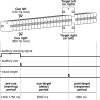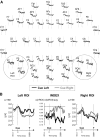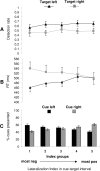Alpha-band electroencephalographic activity over occipital cortex indexes visuospatial attention bias and predicts visual target detection
- PMID: 16971533
- PMCID: PMC6674607
- DOI: 10.1523/JNEUROSCI.0875-06.2006
Alpha-band electroencephalographic activity over occipital cortex indexes visuospatial attention bias and predicts visual target detection
Abstract
Covertly directing visual attention toward a spatial location in the absence of visual stimulation enhances future visual processing at the attended position. The neuronal correlates of these attention shifts involve modulation of neuronal "baseline" activity in early visual areas, presumably through top-down control from higher-order attentional systems. We used electroencephalography to study the largely unknown relationship between these neuronal modulations and behavioral outcome in an attention orienting paradigm. Covert visuospatial attention shifts to either a left or right peripheral position in the absence of visual stimulation resulted in differential modulations of oscillatory alpha-band (8-14 Hz) activity over left versus right posterior sites. These changes were driven by varying degrees of alpha-decreases being maximal contralateral to the attended position. When expressed as a lateralization index, these alpha-changes differed significantly between attention conditions, with negative values (alpha_right < alpha_left) indexing leftward and more positive values (alpha_left < or = alpha_right) indexing rightward attention. Moreover, this index appeared deterministic for processing of forthcoming visual targets. Collapsed over trials, there was an advantage for left target processing in accordance with an overall negative bias in alpha-index values. Across trials, left targets were detected most rapidly when preceded by negative index values. Detection of right targets was fastest in trials with most positive values. Our data indicate that collateral modulations of posterior alpha-activity, the momentary bias of visuospatial attention, and imminent visual processing are linked. They suggest that the momentary direction of attention, predicting spatial biases in imminent visual processing, can be estimated from a lateralization index of posterior alpha-activity.
Figures




References
-
- Babiloni C, Miniussi C, Babiloni F, Carducci F, Cincotti F, Del Percio C, Sirello G, Fracassi C, Nobre AC, Rossini PM. Sub-second “temporal attention” modulates alpha rhythms. A high-resolution EEG study. Brain Res Cogn Brain Res. 2004;19:259–268. - PubMed
-
- Bastiaansen MC, Bocker KB, Brunia CH, de Munck JC, Spekreijse H. Event-related desynchronization during anticipatory attention for an upcoming stimulus: a comparative EEG/MEG study. Clin Neurophysiol. 2001;112:393–403. - PubMed
-
- Bastiaansen MC, Bocker KB, Brunia CH. ERD as an index of anticipatory attention? Effects of stimulus degradation. Psychophysiology. 2002;39:16–28. - PubMed
-
- Brighina F, Bisiach E, Piazza A, Oliveri M, La Bua V, Daniele O, Fierro B. Perceptual and response bias in visuospatial neglect due to frontal and parietal repetitive transcranial magnetic stimulation in normal subjects. NeuroReport. 2002;13:2571–2575. - PubMed
-
- Chapman RM, Ilmoniemi RJ, Barbanera S, Romani GL. Selective localization of alpha brain activity with neuromagnetic measurements. Electroencephalogr Clin Neurophysiol. 1984;58:569–572. - PubMed
Publication types
MeSH terms
Grants and funding
LinkOut - more resources
Full Text Sources
Other Literature Sources
